|
I remember, I remember,
the house where I was born,
The little window where the sun came peeping in at morn;
He never came a wink to soon nor brought too long a day;
But oft since then I wished the night had borne my breath away.
I remember, I remember, the fir trees dark and high;
I used to think their slender tops were close against the sky:
It was a childish ignorance, but now ‘tis little jo
To know I’m further off from Heaven, than when I was a boy.
Thomas Hood (adapted)*
I was born in a village
on the Moray coast of Scotland, to fisher parents whose lineage had both
Pictish and Norse origins, - with possibly some Celtic and Lowland
mixtures. I was later blessed to marry an Edinburgh lassie whose people
were miners of Lowland Scots origins with some Continental traces. My
mother tongue was broad Scots of the Doric variety, - a language we were
not permitted to use at school or in any refined company. Local culture
in my childhood was marked to a degree by the “Scottish cringe”, and the
veneration of a national establishment that was very English in
character. The street where I was born carried such connotations in its
name, “Union Street”, as did the street of the second family home I
knew, “Dunbar Street”, named after Captain Brander Dunbar, the local
Laird. To further identify us with him, there was a Brander Street and
also streets called Victoria, King, Queen, and High, Street (after the
High church).
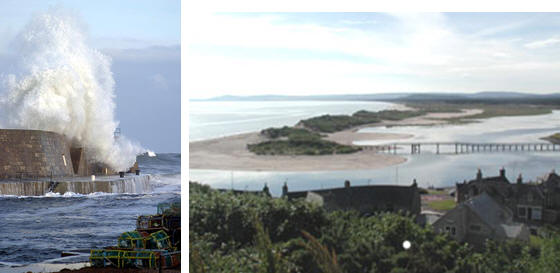
Sea breaking over the north pier Lossie. Typical conditions
following SE swell.
Right : East beach and mouth of the river Lossie.
Morayshire can claim a
unique and rich history stretching back to the period of the Roman and
Viking invasions. Julius Caesar is said to have sent his troops to the
mouth of the river Spey to investigate reports of pearls in the mussels
there. There were (and still are), pearls in those mussels, but they
are tiny and of no commercial value. (As boys we used to collect them
occasionally). Some 50 miles to the east, in Strathmore by Bennachie
just south of the modern A 92 road, the battle of Mons Graupius took
place, when Agricola defeated the Pictish king Calgacus. Burghead
harbour may have been used by the Romans as well as the Norse invaders,
but the date of its historic remnants is uncertain. Huge naval battles
may have taken place in the Moray Firth, between Norse fleets and early
Roman, Pictish or Celtic navies. But these battles took place in the
dim and distant past, and have few references in written history. The
early Christian church was established in Scotland in the 6th century
following the work of an Irish monk Colum Cille (Columba), who followed
men like St Ninian and St Mungo. It was at Loch Ness west of my home
where Columba first met the Pictish king, Brude Mac Maelchon whose
successor Gartnaich is believed to have embraced the Christian faith.
Under its original name
of Moravia, the district of Moray was an independent region of what
became the Kingdom of Scotland. It extended from the river Spey to the
east, to the Dornoch firth on the western side. For some centuries
Moravia resisted the imposition of both Norman Feudalism and Roman
Catholicism, (preferring the traditions of the Celtic Church to those of
the Roman pontiffs). Kings Alexander I & II, and King Malcolm, worked
to incorporate Moravia into the Scottish state, and into the Roman
branch of Catholicism, by appointing a Bishop in Moray in 1107, and by
establishing the Pluscarden Benedictine Priory in 1230. A later Bishop,
David de Moravia, was a leader of the northern independence movement,
for which he was excommunicated by Edward 1st. He went to Norway for
safety, but returned after Edward’s death.
King Macbeth of Scotland
1005 – 1057, was a Moray man, a grandson of Malcolm II, and Mormaer (or
governor) of that province, which was one of seven such districts in
medieval Scotland. He was a fairly competent ruler, by the standards of
the time, unlike Shakespeare’s cruel and tortured character. He is
believed to have resided mainly around Elgin and Burghead, both close to
my home of Lossiemouth, though Lossie town barely existed then, over one
thousand years ago. Being of royal blood, Macbeth was given a strong
Christian education by the monks of the time, as was the practice for
young men of his standing. His cousin Duncan 1 who was killed in a
battle with Macbeth, a few miles from my home town, was a rather
incompetent ruler. Macbeth in contrast displayed both ability and
justice in his administration. In 1050 he made a journey to Rome where
his generous almsgiving was recorded. Writers of his time describing
Macbeth used adjectives such as “renowned, generous, righteous, and
religious”. Some say that he was the last of the Celtic or Gaelic rulers
of Scotland.
Alexander Stewart, the lawless Earl of Buchan, better known
as the ‘Wolf of Badenoch’ a son of King Robert II and brother of King
Robert III, lived near Aviemore, from where he and his “wild, wicked
Heilandmen” made trouble for the authorities, and burnt down Elgin
Cathedral in 1390, after Bishop Bur had disciplined him and
excommunicated him from the Church. He is said to have sired 40
illegitimate children, and got rid of his legal wife to take in a
mistress. Following his misdeeds his father made him go through a public
act of repentance in Perth. However sincere it was, or not, he was
re-admitted to the church, and was later buried in Dunkeld Cathedral.
(In fact the real basis of Alexander Stewart’s quarrel with the Bishop
and other nobles, was over ownership and control of the Badenoch lands,
and of the lands held by his legal wife, Countess Euphemia of Ross who
had her marriage annulled by Papal Edict. The fury exhibited by the
‘Wolf’ at his excommunication, was due more to its impact on his earthly
prospects than his heavenly ones. As a Stewart and a son of the King,
it would have precluded him from ascending to throne of Scotland, had he
become next in line.) Below : A 19th century depiction of the
destruction of Elgin Cathedral by Alexander Stewart, “the Wolf of
Badenoch” in 1390 , and the ruins of the Cathedral, as they appear
today.
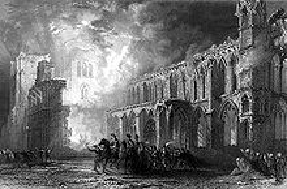
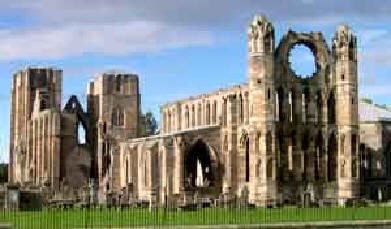
Scotland was ruled from Morayshire for a few brief periods since the
time of Randolph Stewart, Earl of Moray in the 14th century.
Traditionally the Earldom was responsible for government if and when the
monarch was in his childhood. The ‘Bonnie’ Earl of Moray, James
Stewart, a half brother of Mary queen of Scots, was Prince Regent of
Scotland during the infancy of James VI, and a leader of the Scottish
Reformation. He had his home at Forres, in Darnaway Castle, still in
fine condition. He was assassinated at 39 years of age in Linlithgow in
1570. One of our best friends has been taking care of the castle the
past 20 years for the present Lord Moray. Its coat of arms still bears
the motto given it by the Bonnie Earl, - saved through Christ’s
redemption. [The motto is in Latin : “Solus per
Christo Redemptori”.]
Moray, and the city of
Elgin, have seen a few invading armies over the years. The forces of
the English King Edward 1st were there in 1303. During the period 1651
– 58, Oliver Cromwell’s army, or part of it, was in Moray, and they are
credited with destroying much of what was left of the cathedral. In
1746, Charles Edward Stuart and the Jacobite army passed through Moray,
followed by the pursuing force under ‘butcher’ Cumberland, on their way
to Culloden Moor where took place the last land battle ever fought in
Britain. Culloden, the battle site, less than 30 miles from Moray, has
a ‘Stonehenge-like’ circle of standing stones, giving the area a link
with Druids of two to three millenniums ago. The battle of Culloden was
a watershed event for Scotland. John Prebble wrote, “Culloden … began a
sickness from which Scotland, and the Highlands in particular, never
recovered. This sickness and its economic
consequences emptied the Highlands of its people”. [From the author’s
foreword in “Culloden”, by John Prebble.]
The chief of those
consequences was the notorious ‘Highland Clearances’ of the first half
of the 19th century. Those who have read the history of that period,
will recognize the name of Patrick Sellars, factor to the Duke of
Sutherland, who was among the most callous and ruthless of those who
systematically evicted poor tenants from the estates to enrich himself
and make room for more profitable sheep. He came from Westerfield Farm
near Duffus, close to my present home at Covesea, and is buried in the
grounds of Elgin Cathedral. During his term as factor, he would
regularly sail across from the Beauly or Cromarty Firth, to Burghead,
from where he went by horse carriage to the market in Elgin to purchase
tools, equipment and supplies for the estate. The huge Sutherland
estate lies across the Firth from Morayshire, towards the north-west.
The infamous Duke was memorably described by Prebble. [From
“The Highland Clearances”, by John Prebble.] “He was coal and
wool joined by a stately hyphen, and ennobled by five coronets. The
glens emptied by his commissioners, law agents, and ground officers
(with the prompt assistance of police and soldiers when necessary), were
let or leased to Lowlanders who grazed 200,000 true mountain sheep upon
them, and sheared 415,000 lbs of wool every year.”
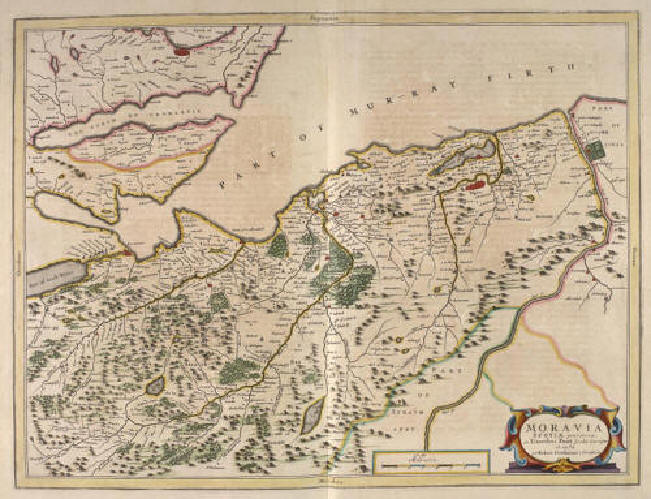
Map of old Moravia, the semi-independent part of medieval Scotland.
Note Spynie loch near the mouth of the river Lossie which was drained
later. Before 1600 it was open to the sea, allowing boats to land at
Duffus Castle and Spynie Palace.
More recently, Morayshire
has been the home of a new age community at Findhorn beside the Kinloss
air station. Gordonstoun school where several members of the Royal
family were educated, lies between Duffus and the RAF Lossiemouth
station. The Duke of Gordon whose home it had been, was reputed to
dabble in the occult, and to be involved in the smuggling trade. The
caves at Covesea nearby had tunnels that may have been used to secrete
contraband goods landed on the beach. They also have some inscribed
Pictish symbols dating back thousands of years. Some tinker families
lived in the caves during the 19th and early 20th centuries. A few were
still around when I was a young boy. They were generally accepted and
treated with a degree of compassion. One notable member of that small
tinker community in my parent’s time was a young woman with the
attractive name of Joyful. A more prosperous group of Romany people
were those who ran the shows and funfairs. Though they lived in
caravans, they were much more urban in their lifestyle than the gypsies
of southern England. A family we knew well, the Hewsons, ran an early
picture house in the town. Old Mrs Hewson was a character, but kindly
and generous. She had one son and seven daughters that I recall. The
family occasionally joined us for Christmas or New Year, and at least
two of them were buried from our house.
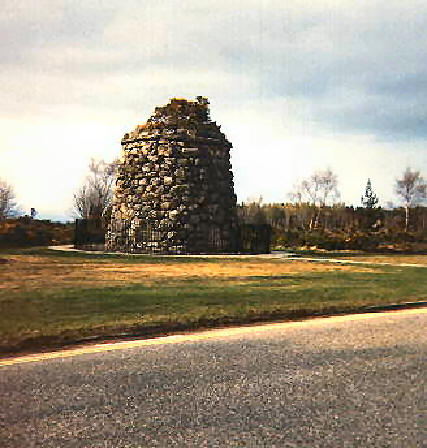
Culloden moor cairn and plaque recalling the last battle ever fought on
British soil.
It saw the end of the Jacobite cause, and the beginning of the
depopulation of the Highlands.
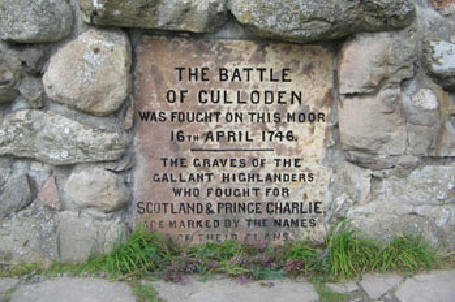
Farming thrived in the
valley of the Spey, Lossie and Findhorn rivers, producing barley,
potatoes, turnip, and other vegetables. Cattle and sheep grew well on
the local grass. Some reforestation took place in the last 50 years,
mainly of fir, silver birch and pine trees. Moray’s coast was the base
of a prosperous mechanised fishing fleet for over a hundred years till
that industry was destroyed by the European common fisheries policy.
There were fleets of small boats at Spey Bay, Seatown and Stotfield
(later merged into Lossiemouth), and at Hopeman, Burghead, and Nairn.
They have practically all gone, and have been replaced with a few yachts
in each harbour. Still flourishing however, throughout inland Moray,
are many whiskey distilleries.
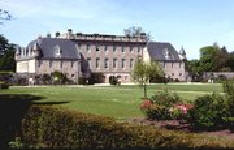
Above : Gordonstoun School, near our home at Wester Covesea.
Several members of the Royal family were educated there.
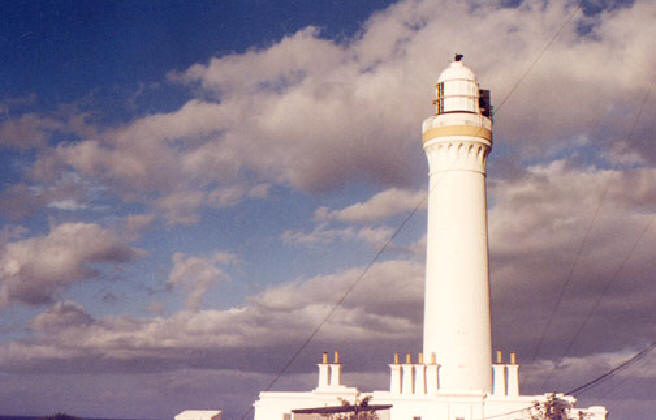
Covesea lighthouse, built by the Stevenson family from whom came the
author,
Robert Louis Stevenson
My hometown has links
with the Stevenson family of engineers that built all of the lighthouses
in Scotland. Covesea light, (Covesea is an anglicized version of
“Caus’ie” or causeway) close to my present home, is one of the
magnificent creations of that remarkable family from which came Robert
Louis, the poet and writer. No doubt he visited the light designed by
his uncle Alan in 1846, as he did most of the family constructions,
during his youth. One of our later homes in Edinburgh was located close
to Swanston farm on the Pentland Hills where a sickly Robert spent some
of his childhood summers, and to the old Colinton Church Manse where one
of his uncles was Minister. And we were often in the New Town where he
was born. Then in my travels, as discussed farther on, I was to retrace
Stevenson’s voyages around the Pacific in the yacht Casco, and visit his
grave on Mount Vaea, in West Samoa. Another famous name who came
regularly to Covesea before moving to Canada, was Alexander Graham Bell,
whose family used to rent a cottage at Covesea village in the
summertime.
The benchmark I always
traced the family history from is my Grandmother’s birth; (my maternal
grandmother who lived with us). She was born in 1868, in the 31st year
of Queen Victoria’s reign, in the middle of the Disraeli and Gladstone
Ministries, and just 3 years after the assassination of Abraham
Lincoln. Karl Marx had just published Das Kapital, and Charles Darwin,
the Origin of the Species, 9 years earlier. That year Louisa Alcott
published Little Women, Charles Dickens was close to the end of his
active life, and Robert Louis Stevenson was a teenage student in
Edinburgh.
The
year she was born, a Lt Colonel in the U.S. 7th Cavalry, George A.
Custer, operating from Fort Riley in Kansas, was massacring Commanche
and Cheyenne Indians, men women and children, and burning their meagre
belongings. He and his troops also raped female Indian prisoners.
Granny was 8 years old when Custer and over 200 of his soldiers were
killed by a Sioux encampment he had attacked, and from whom he did not
expect much resistance, at the Little Big Horn river in Dakota. The
Indians were led by chiefs Sitting Bull and Crazy Horse. Custer’s
campaigns were part of the military efforts to remove Indian people off
lands wanted by settlers and ranchers. Scant heed was paid to treaties
which the American Federal government broke time and time again.
Below : Sailboats and
steam drifters in the óld’harbour in Lossiemouth around 1910, the year
my father was born. The local fleet consisted of open boats powered by
oar and sailduring the 1800s. Steam drifters made their appearance
around 1890 and were at their peak at the outset of WW1. After the war,
the market for salt herring on the continent collapsed with the post-war
economies of Germany, Russiaand Poland. Lossie’s steam drifters were
sold or scrapped during the 1920’s.
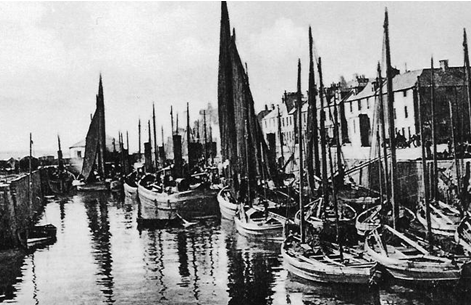
Among the
children of the ‘Seatown’ where Granny lived, and with whom she attended
the two-roomed school at Drainie, just outside the village, was a boy,
two years her senior, by the name of James Ramsay MacDonald, the future
Prime Minister. He was later to build a house for his mother, Annie
Ramsay, in Moray Street, just a few yards up the road from granny’s
modest cottage. Ramsay named the house, “The
Hillocks”. It has its back to the street, and its front facing east
towards the Inchbroom wood and Spey Bay. I have been a welcome guest at
The Hillocks in recent times where JRM’s grand-daughter, kindly allowed
me to peruse his personal library and examine family memorabilia.
Ramsay’s study has been re-assembled with most of its original
furnishings and can be viewed in the Fishermen’s Heritage Museum at the
harbour. His grand-daughter Iona Kielhorn, has put the Hillocks living
room into the form it had when Ramsay visited Lossie, - exactly as it
appears in a photo-graph taken of the Prime Minister sitting by the
fireside, in the early 1930’s.
|
James Ramsay Macdonald
The first Labour Prime
Minister of Britain, James Ramsay Macdonald was born in my home
town of Lossiemouth on 1866, the only son of Annie Ramsay, a
servant girl who never married. He attended the local two-room
Drainie school just outside the village, near the present RAF
station. The teacher was a James MacDonald (no relation), who
was assisted by a sewing mistress and a pupil-teacher, to handle
the total of 70 pupils. Ramsay was kept on for a while as an
assistant teacher after he graduated. He later went to London
and Bristol where he found newspaper work, and married a
Margaret Gladstone from a middle-class family.
He joined the early Labour
Party, and was much admired by socialists and Fabians, including
Beatrice and Sidney Webb. He was elected a member of parliament
for Leicester in 1912, and joined Kier Hardie and other early
socialists at Westminster. He had pacifist views and opposed
Britain’s participation in the First World War. This stance
attracted a lot of criticism. Back home, he was ordered off the
golf course by the club secretary in 1915, and had his
membership terminated the following year. The secretary of the
Moray Golf Club, Jock Foster, Solicitor and Sheriff Clerk at
Elgin city, was by most reports, an arrogant man who later
became an alcoholic and eventually died in Bilbohall hospital
(the Elgin mental asylum) in 1946, nine years after the man he
scorned and kicked off the golf course had been buried with
national honours as a three time Prime Minister of Britain. (In
those pre-NHS days alcoholics were often cared for in mental
hospitals).
After the war Ramsay was
elected for Aberavon. In 1924 King George asked MacDonald, then
leader of the Labour Party, to form a government, which he did,
but it did not last the year, due to a scandal known as the
“Zionovev letter” which now appears to have been fabricated for
that very purpose. Gutter politics are not a modern invention!
Poor Ramsay often had his
illegitimacy and lack of wealth used against him. The English
newspaper John Bull, once printed a copy of his birth
certificate. Alexander Grant of Forres, owner of the McVitie &
Price biscuit company, provided Ramsay with table silver for 10
Downing Street, and a car for his use in Lossie. Grant later
received a knighthood, and even that sensible honour was a cause
for slander in the Tory press. Grant well deserved the title,
unlike the scores of Tory sycophants who were ennobled or
granted medals for little apparent service to the country. (Alex
Grant himself was a poor boy who was apprenticed to a bakery in
Forres which later developed into the large McVitie and Price
company. His breakthrough came when the manger asked to taste
some biscuits he was eating for lunch, which had been made by
his mother. The bakery boss said they were extremely good and
asked for the recipe. Young Alex declined to give it but offered
to help the business produce them. That was agreed and the home
bakes became the now well known ‘Digestive’ biscuits.)
Ramsay was Prime Minister
again 1929 – 1931, of the second Labour government, and from
1931 to 1935 of a coalition government formed to get all-party
support to fight the recession since his own party rejected his
over-cautious approach. Most Labour members saw this as
betrayal and the party has regarded him as a political traitor
since. They also felt that MacDonald became too friendly and
comfortable with the aristocracy, and enjoyed their apparent
adulation. There does seem to have been something of the rural
peasant’s respect for the genuine aristocrat in Ramsay, despite
his strong social beliefs.
His three administrations
failed to deal effectively with the economic crisis. His
Finance Minister, Philip Snowden clung with doctrinaire
tenaciousness to the gold standard and refused to devalue the
pound, which effectively ensured that the recession would
continue. Oswald Mosley, later the leader of the British
Fascist party, was a Labour MP and Minister then. He argued for
a Keynesian program to put the unemployed to work on nation-wide
re-forestation programmes. It could have been the basis of a
British “Tenessee Valley Authority” type economic intervention,
but no-one else in MacDonald’s cabinet had the vision to see its
potential. The plan was rejected and Mosley became a fascist.
Lacking an imaginative economic recovery programme Ramsay was
obliged to form a coalition government to tackle the recession.
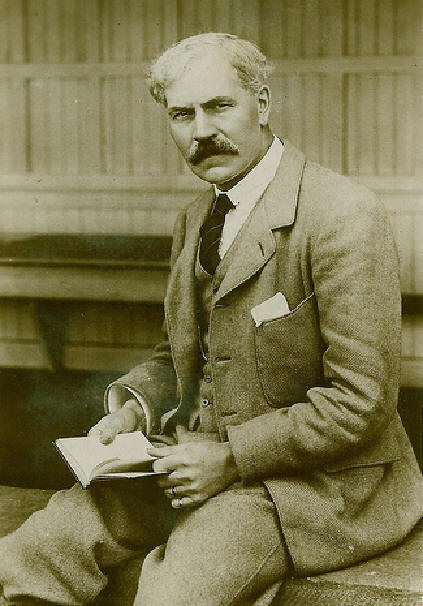
James Ramsay MacDonald, three times Prime Minister of Britain
Some observers believe
that MacDonald was a spent force when he came to power.
Certainly he never got over the untimely death of his wife
Margaret Gladstone in 1911. He was a great believer in world
peace, and was a principal founder of the ill-fated League of
Nations. He foresaw the second world war due to France’s
intransigence over the conditions of the Treaty of Versailles,
and died in some disillusionment in 1937. He is buried in
Spynie churchyard by the ruined palace of that name, half-way
between Lossiemouth and Elgin.
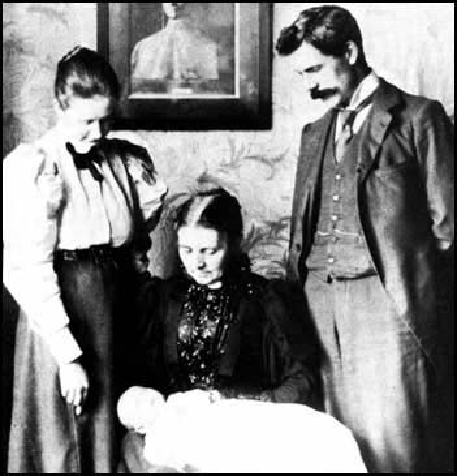
Ramsay with his wife Margaret Gladstone, and mother, Annie
Ramsay,
and their first child that died later in infancy.
Ramsay’s son Malcolm was
later British High Commissioner in Canada, and served as
Governor in Borneo, Malaysia, Kenya and India. He was always
plain “Mr.” MacDonald, having refused offers of knighthoods and
elevation to the peerage. His sister Ishbel, once her father’s
housekeeper at 10 Downing Street, married a local chemist and
lived out her days in Lossie. She invited my father and mother
to meet Malcolm on one of his last visits to Lossie. The former
High Commissioner and Governor General sat on a little stool in
the corner of her living room, and chatted away happily with all
visitors from the eldest to the youngest. |
The city of Elgin was and
is, quite small as cities go, with a population of only ten to twenty
thousand persons. It was typical of the towns serving a surrounding
agricultural area. It has produced a number of persons of achievement,
including a notable writer Jessie Kesson, who came from an extremely
deprived background to produce novels of remarkable insight. Another
successful person was a chemist, George Thomson, (no relation), who made
an excellent (and very palatable) cod liver oil cream that was marketed
until the 1950’s. He won the Moray Open golf championship in 1913, and
was presented the trophy by Prime Minister Asquith’s daughter.
Lossiemouth was known for
other things than being the birthplace of a Prime Minister. But for
most of the British public, that was it. When first encountering Labour
Party scorn for our local hero, as a young lad, I had no idea why he
earned it. I recall a Strube [Strube was a Daily
Express cartoonist between the wars, - a Giles before his time, though
more political.] cartoon of the 1930’s with the cartoonist’s
little man passing seasonal compliments to various politicians.
“Christmas greetings”, he said to Ramsay MacDonald, “you’re the best
Prime Minister we’ve ever had, - from Lossiemouth”. The town was a
combination of three villages, - Seatown (or old Lossie), Branderburgh
with the harbour and town square, and Stotfield to the west. It came to
life in the 19th century with the construction of the lighthouse, the
installation of electricity, the extension of the railway line, and the
construction of the two harbour basins. The end of that century saw the
rise of the herring industry, and the rapid growth of a local fleet of
steam drifters. At one time there was a sign at the main railway
station in London, declaring “King’s Cross to Lossiemouth”. That was as
far north as the LNER line went. During the 1930’s the town had a major
air station constructed nearby. RAF Lossiemouth is presently the base
of Tornado squadrons and air-sea rescue helicopters. For some years
after the war it was a naval air station, under the name RNAS Fulmar.
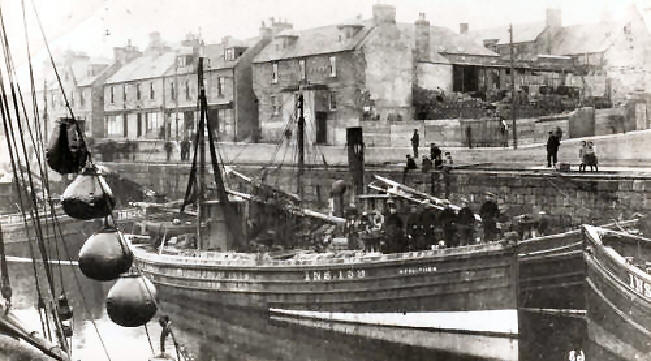
Motor fishing boat Prestige, owned and operated by my paternal
grandfather and his sons. (circa 1925).
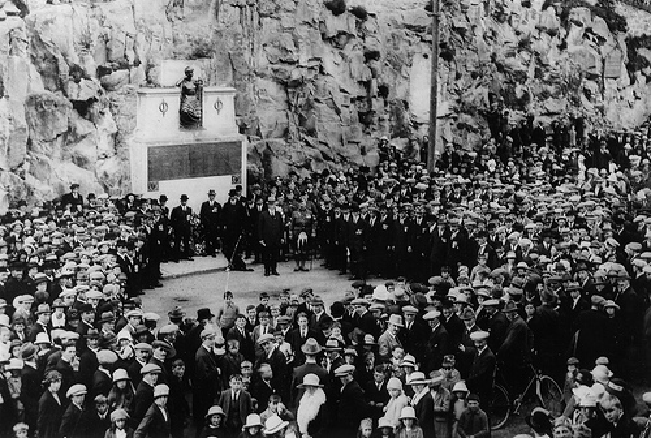
Unveiling of the WW1 War Memorial, 1923. My mother’s father is in the
foreground in the left hand corner. He was killed crossing the railway
line the following year. Below left : my mother and grandmother with
myself and my older brother as infants.
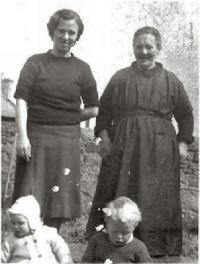 Granny
was a character, - very typical of working class Scots of her time. She
was firm, thrifty, hard working, honest to a fault, but also generous
and sympathetic. Like many Scots she did not hide her opinions, and
would not hesitate to contradict someone she disagreed with. She had a
store of old songs and ditties, and I wish I’d taken enough interest to
jot some of them down on paper. Long after her death I learned some odd
things about Granny from a local woman who ran errands for her. (My
mother would not have mentioned certain matters). One was that she
smoked a pipe, which was not uncommon in women of her class and time.
The other was that she enjoyed a wee dram. It had to be a wee one. She
never had money for luxuries. Her elderly line fisherman husband had
been killed in 1924 by the local train on his way to gather mussels for
bait. Granny
was a character, - very typical of working class Scots of her time. She
was firm, thrifty, hard working, honest to a fault, but also generous
and sympathetic. Like many Scots she did not hide her opinions, and
would not hesitate to contradict someone she disagreed with. She had a
store of old songs and ditties, and I wish I’d taken enough interest to
jot some of them down on paper. Long after her death I learned some odd
things about Granny from a local woman who ran errands for her. (My
mother would not have mentioned certain matters). One was that she
smoked a pipe, which was not uncommon in women of her class and time.
The other was that she enjoyed a wee dram. It had to be a wee one. She
never had money for luxuries. Her elderly line fisherman husband had
been killed in 1924 by the local train on his way to gather mussels for
bait.
She worked hard for
minimal wages to support her children till they were each through school
and earning wages. An earlier child she had in her youth, emigrated to
Canada where she went to work in the Yukon. Nell, a woman of sterling
pioneering character, married out there and raised a family in
Vancouver. Like many Scots emigrants she sent food parcels regularly to
her mother. Granny loved fish, and was the only person I recall making
“lichners”, small, semi-dried salted haddock which were roasted over hot
coals on the fire. They were the sweetest fish I ever tasted. I slept in
the same room as granny for a few years, and to this day can recall her
murmuring her evening prayers which to a wee boy, pretending to sleep,
seemed to continue for hours. My happiest memories of Granny are of
going round the garden to lift vegetables for the dinner. She would
often stop to make a whistle for me out of a leek, or once back inside,
make me a memorable bowl of brose, (a dish seldom seen in Scotland
now). She was adept at making jams, and her broth and tattie soups
were superb!
My mother had her hands
full looking after a fisherman husband and three sons, (our sister
arrived much later), with an unmarried brother and her mother all
staying with us in a bungalow that had just 2 small bedrooms and an
attic used by my bachelor uncle and my older brother. Before her
marriage she worked for Mr and Mrs David West who lived in a house
perched precariously on a shelf above the sea shore. David West was an
artist whose paintings are highly valued today. But like most artists
he struggled to make ends meet during his lifetime. Mother would take
me on the double-decker Bluebird bus to Elgin once a week to meet up
with and buy some eggs from a cousin of her mothers from Fogwatt village
in the country where she kept a few hens. While in Elgin, the main
treat would be a sweet out of Woolworths. Sweets were rationed and
required a contribution of ration book coupons which were used with
care. When my father fished in the Republic of Ireland, which did not
have any rationing restrictions, he would return with a suitcase full of
sweets that were liberally distributed among my friends. Nylon
stockings and other feminine luxuries were brought back for mother and
her friends.
Mother’s brother, my
bachelor uncle, was a gardener then. A voracious reader of non-fiction
(I believe he had a prejudice against novels), he maintained a sizeable
library of Penguin and Pelican paperbacks, biographies, and accounts of
famous trials. There was an old wind-up gramophone
in the attic cupboard by his bedroom. We would search among the rusty
needles to find one that would not scratch so much, and then listen to
His Master’s Voice recordings of Paul Robson, John McCormack, Robert
Wilson and other singers of that period. As a boy my uncle had had a
newspaper round, and used to recount which papers he would deliver to
the different members of Ramsay MacDonald’s cabinet and shadow cabinet,
when they came to Lossiemouth for meetings in the Stotfield or Marine
Hotel there, when Parliament was in recess. According to one of his
grand-daughters, Ramsay once brought Ghandi to Lossie, but no-one
remembers setting eyes on him. Perhaps our weather kept the Mahatma
indoors.
Recollections of my
father are dim for early childhood, probably because he spent long
periods away at sea. When at home he loved to take us across the golf
course on a Sunday (there was no Sunday golf then), and show us bird’s
nests which he was adept at locating. The wooden lifeboat that fishing
vessels carried then was often left ashore to make room for fishing
gear. Dad would row us out on his one, to the offshore rocks of the
Skerries in the summer, and would whistle to attract the seals
alongside.
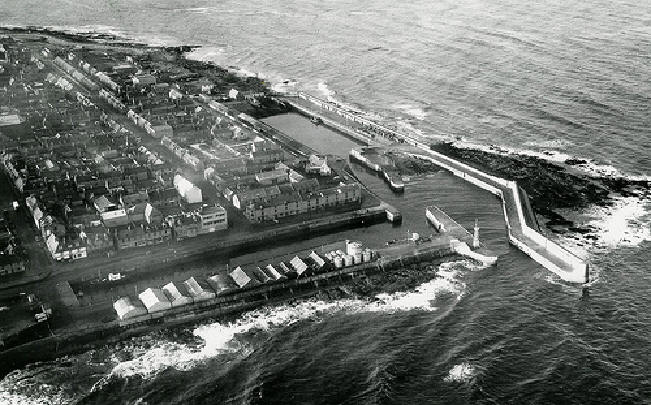
Lossie harbour from the air
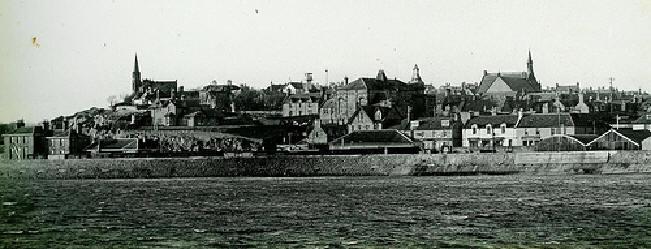
Lossie town from the sea
Apart from the three
uncles on my mother’s side, there were seven uncles and two aunts on my
father’s side, - plus their spouses. The family enjoyed great
camaraderie and would rally around each other at times of crisis or
bereavement. It was a treat on occasional Sunday evenings to gather
with them at my paternal grandmother’s house, and hear them share their
news and views. As a young boy I regarded their collective wisdom with
some awe and admiration. The wives would meet once a week at each
other’s homes for an afternoon tea and gossip. All the while they
talked, their knitting needles clicked away speedily as they made
jerseys, pullovers, cardigans and kiddies clothes with great skill.
Their cable stitch jersey patterns were particularly admired by visitors
from the south.
My Father was never a
reader, but he was a great conversationalist, and as such was welcome in
any company. I have never met his equal at striking up conversations
with complete strangers in a railway carriage, and keeping them
entertained, to their obvious pleasure, the whole journey. He was one
of the finest tellers of jokes, and could make almost any tale sound
humorous. Children everywhere loved uncle Jimmy as they called him. He
had an enormous store of practical jokes and conjuring tricks that never
ceased to fascinate them. Dad was also the most non-judgemental person
I have ever met. He looked on none with prejudice, and could befriend
almost any type of person. Despite his noncomformist background, he
warmly embraced believers from all denominations. He was as happy in
the company of Catholic nuns as he was with Salvation Army girls. There
were only two human traits I recall that angered him. One was meanness,
and the other was religious hypocrisy. Most human weaknesses he regarded
with compassion. Once when fishing in Ireland, he had mentioned to the
local Gardai police in Galway that fish baskets were regularly
disappearing from the deck when the boat was in port. He was annoyed
later when he was asked to appear in court as the authorities had
recovered the baskets and arrested a culprit. The man who was found
guilty was unemployed and had a large family. He was given a severe
lecture by the magistrate and fined for his misdeed. My father went to
the court clerk afterwards and paid the fine for the man. That was
typical of him.
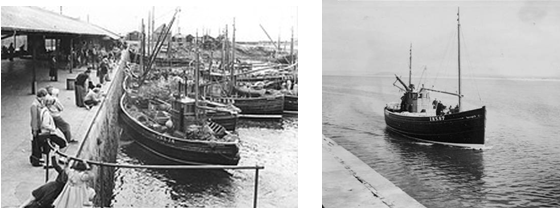
Boats landing their catches at the fish market My
father’s first boat, the Amaranth, 1934
He was a conscientious
objector during the war, but volunteered for the medical corps and for
non-combatant service in the merchant navy. The tribunal, however,
treated him with surprising respect and decided he should continue to
fish to help maintain that part of the country’s food supply. Such
concessions were regarded with some odium in the community since it
permitted the ‘CO’s to earn good money, but my father never mentioned
the criticism he must have received, though mother once alluded to white
feathers stuck to their front door. Other uncles served mostly on MFV
tender boats in Scapa Flow. One maternal uncle joined the army and was
among those rescued at Dunkirk. One of my father’s brothers served in
the latter part of the First World War, but it was from my wife’s family
that I have more stories of that conflict.
|
World War 1 Memories
My wife’s family had some
interesting wartime experiences. Her grandfather’s brother who
often stayed with them after he was widowed, was a sapper during
the first world war. He spent some months at the front near
Ypres and witnessed much of the carnage in the dreadful trenches
and occasional hand-to-hand combat in no-man’s land. Coming
from a mining community, he knew of the underground tunneling
the army organized to place explosives underneath the German
trenches. He often told of a time when a German pillbox armed
with machine guns was cutting down attacking troops.
Eventually, with the support of tanks, the British ‘Tommies’ got
close enough to lob grenades into the pillbox which then fell
silent. Andrew was one of the first to enter the damaged gun
position. As was the custom with troops of the time, he took
some souvenir items from the bodies of the German troops, which
he brought home with him after the war ended.
Years later, back at home
in Scotland, Andrew was examining the items which included
letters and a Bible inscribed to the young soldier Karl Fritz
from his mother. He thought, “maybe this man’s family would
like to have these things”, and so he wrote to the family
through the German consulate. You can imagine his surprise a
few months later to learn that the soldier’s family in Bavaria
were indeed pleased to receive the materials, but also that
Fritz himself, was still alive. He had only been blinded and
knocked unconscious by the blast. An Edinburgh doctor helped
restore his eyesight at a prisoner of war hospital, and he was
repatriated after the war. The family invited Andrew to visit
them in Germany. For domestic reasons he was unable to go, but
sent his son instead. The story gets more intriguing in that
Fritz’ son was captured during the second world war in the same
locality where his father was nearly killed. Information
reached Andrew who sent food parcels to Fritz junior, to the
prison camp in France, something the authorities sternly
disapproved of. After the second war, both families were to
meet again in Scotland and in Germany.
Another story from the
first world war illustrates the insanity of our governments
training and sending young men out to kill, who in ordinary
circumstances would have no ill feelings towards each other at
all. A fish merchant friend of my father’s Johnny West, who had
a share in the family boat, was a soldier in the first world
war. Sometimes, particularly if he had taken a drink (not that
he was a drinker), a memory would come flooding back that he
would have to share, - rather like Coleridge’s Ancient Mariner.
It concerned his first contact with German troops at the front
in France. He had charged with his company out of the trench
and across no-man’s land where they met the oncoming enemy. A
German soldier lunged at him with his bayonet, but John
sidestepped, deflected the blow as he had been taught in
training, and brought his own bayonet up into the man’s chest.
The young soldier collapsed, mortally wounded. Johnny knelt
down beside him and the man motioned to him to take a wallet
from his pocket. Inside were letters and pictures from his
family. The German indicated he would like Johnny to write to
them and tell them what happened. This Johnny assured him he
would do, and with that the young soldier died. Johnny used to
say that once that incident was past, he could have killed the
whole German army and it would not have bothered him; but that
first action of taking the life of another human being stuck in
his throat, and remained etched on his conscience for the rest
of his life.
Similar deep traumas faced
our troops during the 2nd world war. A D-Day veteran Frank
Rosier, recounted on BBC television how he shot and killed a
young blonde German soldier at close range in France in 1944.
Frank sat down beside the shattered remains of his enemy and
wept like a child.
The Conservative Member of
Parliament from Buckie, Sir William Duthie, who was later to
show me around the House of Commons, and who kindly wrote the
foreword to my first book, told me of his WW1 experiences. He
was wounded at Passchendaele, and lay
bleeding from wounds in the mud of no-man’s land for two days.
Eventually he was found and taken to a hospital where he
gradually recovered. The experience affected his attitude to
life from then on. While he was convalescing, he received a
letter from an older acquaintance, a schoolteacher who he had
thought before never held a high opinion of him. The writer
said that he believed Bill had the character and ability to
accomplish anything he set his mind to in life. Young Duthie
took that to heart and went on to a career in banking in Canada,
then in food supply organization in Britain during the second
war, then as a Member of Parliament for his home county of
Banffshire, and latterly as one of the finest honorary Chairmen
of the R. N. Mission to Deep Sea Fishermen. |
My grandparents’
generation lived through the period when the ‘workhouse’ was an ever
present danger to those who fell into destitution. The fear of that
dreadful place must have led to the virtues of thrift, hard work and
independence that characterized the sturdy sterling peasant people of
that time. The little city of Elgin produced such a character.
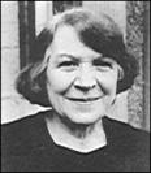 She was
actually born in Inverness, and brought up in Elgin, before being moved
to an orphanage in Skene. But Morayshire was the land she always
claimed as home. Jessie Grant MacDonald was born in a workhouse in
1916, and like the Dickensian waifs she resembled, she was
illegitimate. Her poor mother was a rich store of songs and poetry but
Jessie was taken from her by the authorities in Elgin while still a
juvenile. After orphanage and some farm service, she married a Johnnie
Kesson, a skilled farmhand. They moved to the Black Isle where the
couple had two children. Jessie possessed a remarkable skill in
writing, particularly in the Doric tongue. Her abilities were noticed
by Nan Shepherd and Neil Gunn, and she was soon writing for the Scots
Magazine, and for BBC Aberdeen radio. She was
actually born in Inverness, and brought up in Elgin, before being moved
to an orphanage in Skene. But Morayshire was the land she always
claimed as home. Jessie Grant MacDonald was born in a workhouse in
1916, and like the Dickensian waifs she resembled, she was
illegitimate. Her poor mother was a rich store of songs and poetry but
Jessie was taken from her by the authorities in Elgin while still a
juvenile. After orphanage and some farm service, she married a Johnnie
Kesson, a skilled farmhand. They moved to the Black Isle where the
couple had two children. Jessie possessed a remarkable skill in
writing, particularly in the Doric tongue. Her abilities were noticed
by Nan Shepherd and Neil Gunn, and she was soon writing for the Scots
Magazine, and for BBC Aberdeen radio.
In 1958 she published her
first book, The White Bird Passes. It is a moving account of her early
childhood, and the deprivations and hardships she had to endure. This
was followed by Glitter of Mica in 1963, and Another Time, Another
Place, in 1983. By this time she was writing scores of plays for radio,
and even produced BBC’s Woman’s Hour, for a period. In 1980 the
Universities of Aberdeen and Dundee awarded Jessie honorary degrees, - a
wonderful tribute to the illegitimate workhouse child brought up in the
back streets of Elgin. Jessie Kesson died in London in 1994.
An interesting aside to
her origins (which might have made great material for a Dickens novel),
concerns the identity of her father. Local reports in the town library
records indicate that it was believed he was the Sheriff Clerk and local
Solicitor, Jock Foster, though he never owned her publicly or made any
contribution to her upkeep or education. Foster’s main claim to fame
was the removal of Ramsay MacDonald from membership of the Moray Golf
Club for his anti-war pacifist views. Interestingly, Jessie’s
conception and birth occurred during the year of those events. One
could scarcely conceive of more different lives, and more different
characters than Jessie Kesson and her reputed parent, the arrogant Jock
Foster. If the story is correct, then at precisely the time when he was
having Member of Parliament J. R. MacDonald removed from the Golf Club,
he was using, or indulging in an illicit affair with, a poor Liza
Macdonald in Elgin where he was a prominent citizen, and she lived in
the local workhouse from where she was at times procured by male
clients.
The first five years of
my life were the years of World War 2. I was born just after British
troops evacuated from Dunkirk, and Hitler’s forces took over Paris. One
of my mother’s brothers, Uncle Joe Baikie, was involved in the Dunkirk
evacuation. I recall him relating to me his account of that event when
I was still in primary school. That was the year of the Battle of
Britain that turned the tide of war and prevented a German invasion from
taking place. The young Spitfire and Hurricane pilots who held the
Luftwaffe at bay, rightly earned the respect and admiration of the whole
nation. As Churchill put it so well, “Never in the history of human
conflict, was so much owed by so many to so few”. But other armed
forces branches suffered severe losses, including the Army, Navy, and
merchant navy. Our little community lost local men in each of these
services.
My memories of the war
years are of service personnel in uniform, nissen huts, tanks traversing
our streets and breaking up the tarmac in places as they did so. I also
recall well the ration books with their precious coupons. Shops lacking
fresh foods, sold powdered eggs, and powdered milk. I think it was
after the war that the Attlee government provided vast quantities of
concentrated orange juice as a health food supplement for children.
Strangely, after a few years the orange juice lost its attraction, and
the public started to buy more expensive commercial juice which was
probably of a similar quality. Overall I do not recall any deprivation
or hardship in the war years. [Interestingly, an East
German friend of mine, now deceased, who fought in the war, and was
brought up during the 1920’s and ‘30’s, told me that he had no childhood
recollection of hardship in Germany though it certainly existed.]
We were more fortunate than city people, having regular access to fish,
and to produce from local farms or gardens. However, like most families
our diet was modest. Chicken was something we saw once a year, at
Christmas. It is strange recalling that now when it is a common and
low-cost meal. Food parcels from my mother’s half sister in Vancouver,
Canada, were a special treat during and after the war. I well remember
the Betty Crocker’s cake mixes. [Apparently there
never was a ‘Betty Crocker’. The name was concocted by the Mills food
corporation to add a personal touch to their flour and baking products.]
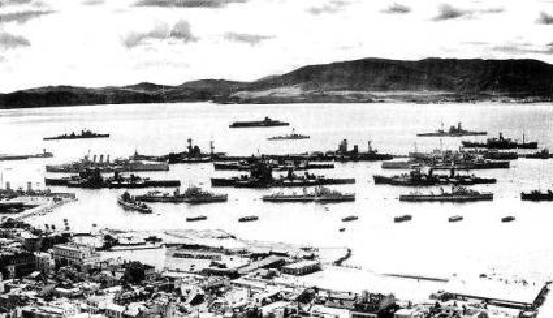
Scapa Flow where many fishers served during WW2
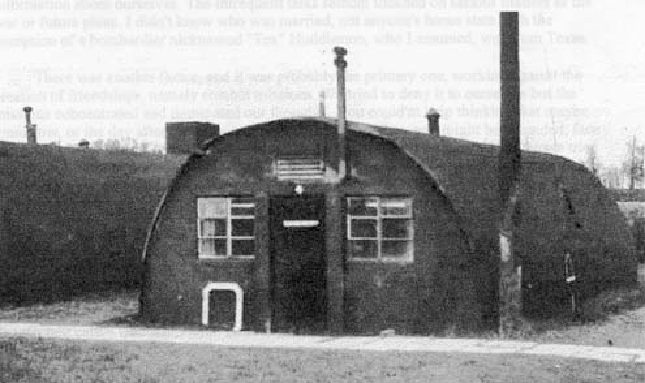
A Nissen hut from WW2 days
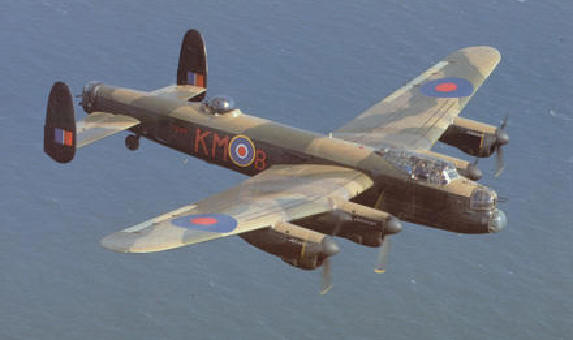
A Lancaster bomber of the RAF. Such planes from RAF Lossiemouth sank the
German battleship Tirpitz in the Norwegian Tromso fjord on 12 November
1944. The 617 squadron was led by CO JB Willy Tait, and was formerly
commanded by Guy Gibson and Leonard Cheshire.
Servicemen and service
women were often in our house. In wartime days, most doors were open to
them, and some lifelong friendships were formed then. I remember the
service women who visited my mother – the “WAAFs” as we called them. My
bachelor uncle told of a slightly amusing incident when a Polish soldier
who had practically no English, came into a house one evening where he
was sitting in the kitchen chatting with the housemaid. There was
little else to do in a wartime village evening, but visit. The Pole sat
with them for a while but as he could make little conversation, became
somewhat uncomfortable. Pulling a Polish-English dictionary from his
pocket, he found a word to which he drew my uncle’s attention. Looking
at the maid and my uncle, he pointed to himself as he indicated the word
with a question on his face. The word was “obstacle?” !
There were Nissan huts
and pill boxes all around town, and our beach still contains the huge
concrete blocks that were erected in rows to hinder invasion. Barbed
wire was a constant danger to young boys and we often tore clothes or
cut our feet when playing around it. Today all trace of the barbed
wire, Nissan huts and bomb shelters is gone. Only the beach guarding
concrete blocks and some pill boxes remain.
Our garden contained a
concrete air raid shelter, a rather flimsy construction as I recall, and
we had both gas masks and tin helmets in the house. A regular broadcast
we listened to was from the “British Forces Network in Germany” with
Wilfred Pickles as compere, and the theme
tune, “Have a go Joe, come and have a go”. By then I guess the war had
ended, though apart from a faint memory of flags on Victory Day, I
scarcely recall its passing, or the explosion of the first atom bomb,
three days after my 5th birthday, or the horrendous destruction of
Hiroshima and Nagasaki the following month.
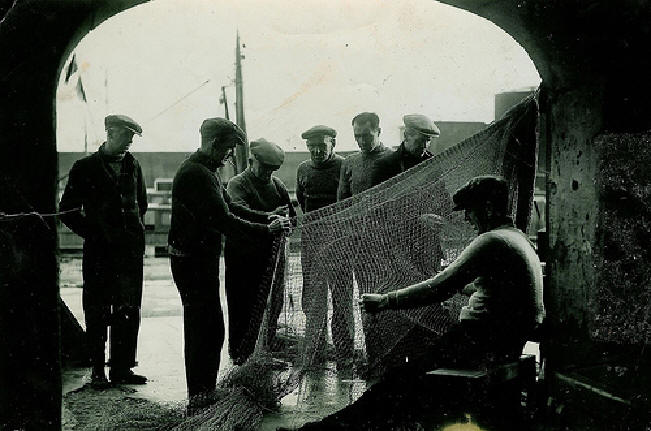
My father and crew of the MFV Resplendent repairing gear at their net
shed
which is now a fine restaurant.
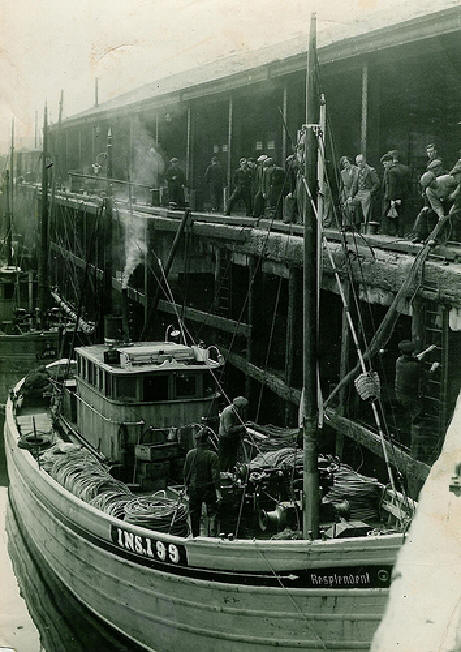
The Resplendent INS 199 in Aberdeen, 1946, after rescuing the crew of
the Newark Castle when that trawler sank in the North Sea. Over ten
years later we met the skipper of the Newark Castle in Scrabster. He
asked my father if the company that owned it ever thanked him for the
rescue. My Dad told him that they had not, but that they just sent a
lorry to collect a trawl net and deck gear the crew had retrieved before
the boat sank. The skipper’s comment then was unprintable
! (Ressplendent was my father’s second command). |

